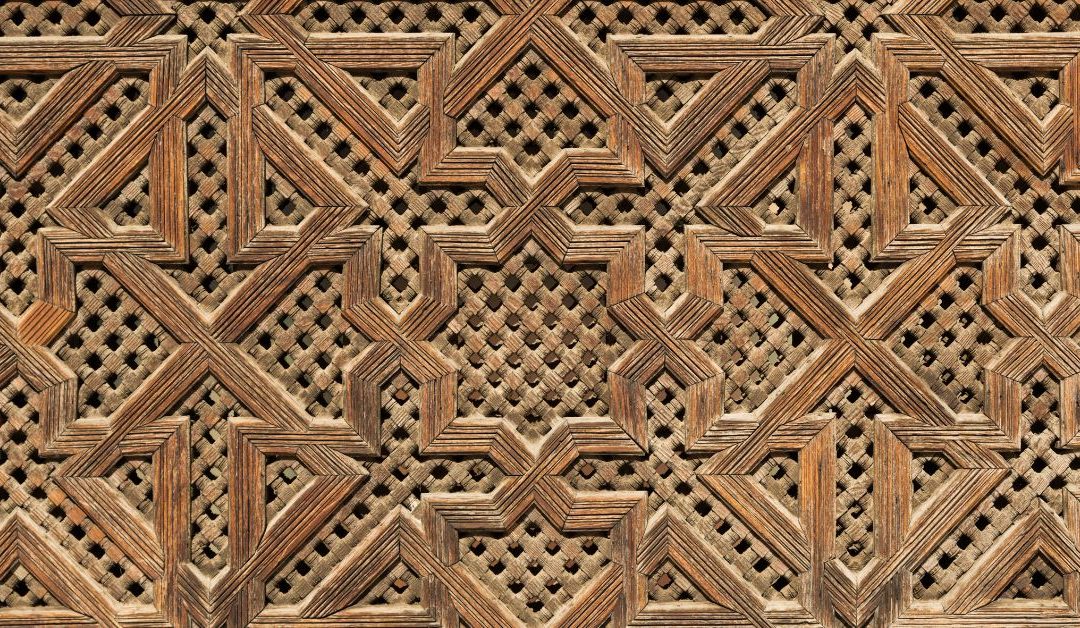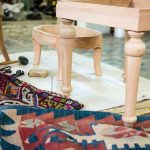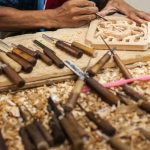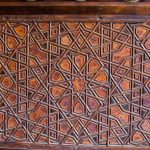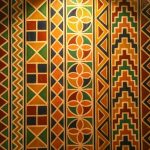Moroccan woodworking is an important part of the culture in this region. It’s not only about making things look pretty, but it carries a lot of meaning too. The designs, patterns, and symbols used in Moroccan woodworking have deep cultural significance.
For a very long time, these woodwork pieces have been important to the people of Morocco. They remind them of their culture and heritage. You can find these designs and patterns on everyday things like furniture and even in big buildings like mosques. In this article, we will explore the meaning behind some popular designs and patterns in Moroccan woodworking. Plus, how they connect to the traditions of the past and present in this special North African country.
Geometric Patterns
Moroccan woodworking designs and patterns are very detailed and fascinating. They have stayed for a long time used to decorate furniture, buildings, clothes, and more. These designs have special meanings that have a connection to Moroccan culture and history.
One common type of design in Morocco is the geometric pattern. These patterns have shapes like spirals, stars, and interlocking shapes. They look like they are moving and have a lot of energy. Each pattern has its meaning and tells us something about the people and traditions of Morocco.
Artisans in Morocco get inspiration from nature when they make their carvings. They create designs that have many small details and sometimes have big, bold parts too.
These wooden carvings are important to Morocco and have a big impact on the people who live there and the visitors who come to see them. They show the beauty of Morocco and its traditions. In the future, we will learn more about how floral designs make these carvings even more interesting.
Floral Motifs
In Moroccan woodworking, there are two main styles: geometric patterns and floral motifs. People who make and buy them love both styles, but they have some differences.
Floral motifs are very important in Moroccan culture and have special meanings. Different flowers represent different things. For example, orange blossoms represent purity, lilies represent innocence, and roses represent beauty. These flowers are often used in wooden carvings, furniture, and home decor.
Sometimes, you can find plants with negative meanings, like thorns or cacti. They can represent challenging times. It’s like when people wear black jewelry to show they are mourning. Experienced artisans design each flower and plant in Moroccan woodworking with great care. They do this as they carry their special message.
Apart from floral motifs, Moroccan woodworking includes traditional symbols that have special meanings. This can be present in hand-painted ceramics that show ancient gods or carved trunks that tell stories from folklore. These symbols have deep cultural significance and show the true depth of this timeless craft.
Traditional Symbols
People have been using symbols in Moroccan woodworking for a very long time, and they still use them today. They have special meanings and come from different cultures in Morocco. Some symbols are from Arabic culture, and others are from Berber culture.
The symbols often have spiritual meanings and can represent various things. These include health, protection, or making something look nice. People believe that having these symbols in their homes or workplaces brings positive energy.
Each symbol is unique and has its power. Some can protect themselves from bad luck, while others might bring wealth or success. Even if a symbol doesn’t have a specific meaning, its beautiful shape is still appreciated.
Making these symbols requires a lot of patience and careful work. Artisans must pay close attention to every detail, or they could make a mistake and ruin hours of work. Woodworking is an important part of Moroccan culture and heritage.
Next, we will explore how Moroccan woodworking designs incorporate calligraphy.
Calligraphy
In Moroccan woodworking, the designs and patterns are very detailed and beautiful. They use calligraphy, which is a form of writing, to decorate the furniture and wooden items. Craftsmen use Arabic script, which is a special type of writing, to add beauty and meaning to the pieces. People have been using calligraphy for a long time, even in religious texts like the Quran.
The letters in the calligraphy are very elegant and are often paired with geometric shapes to make them look even more appealing. There are different styles of calligraphy, like Thuluth, Naskh, Diwani, Kufic, and Muhaqqaq. Each style has its unique look.
Whether it’s in traditional mosques or modern homes, the calligraphy adds a sense of importance and beauty. It conveys meaningful messages and symbols that many generations have used.
When creating these woodworks, using different colors and finishes is also very important. It helps make the final piece look even more stunning and like a true work of art.
Color And Finishing Techniques
In Moroccan woodworking, the colors and finishes used have special meanings. Artisans use colors to send messages with their designs.
They use different techniques to finish the wood and make it look nice. They can wax or stain the wood to create unique and beautiful pieces.
Every woodworking project has its special combination of colors and finishes. Thus, the result is always something amazing.
Color Symbolism
In Moroccan woodworking, the colors and patterns used are very special and meaningful. They represent the beliefs, symbols, and spiritual ideas that have been important in Moroccan culture for a very long time.
Colors in Moroccan woodworking have special meanings. Red means passion and strength, blue means wisdom, green means growth, and yellow means energy and joy. These colors help create a balance between the outside world and our feelings.
When Moroccan woodworkers make their pieces, they put their culture into it. They show things like love, faith, hope, and family values. By looking at their work, we can understand how they think and appreciate the beauty of their craft.
Finishing Techniques
In traditional Moroccan woodworking, artisans consider the finishing techniques. They consider it to be as important as the colors they use. The finishing methods like staining, polishing, and sealing help protect the wood and make it look even better. There are dyeing methods like waxing, bleaching, and toning that add depth to the colors.
Skilled craftspeople who are good at paying attention to details can create something special. They ensure they take every step with care to achieve perfection. It’s all about making decisions and taking action with care to create a beautiful work of art.
Intarsia And Marquetry
In Moroccan woodworking, there are two important techniques called intarsia and marquetry. Craftsmen use these techniques to create beautiful designs using pieces of wood.
With intarsia, craftsmen use different kinds of wood to make colorful mosaics. They cut the wood into different shapes and put them together like a puzzle to create pictures or patterns.
But, marquetry involves using thin slices of colored wood to make patterns on the surface of the wood. They cut the wood into precise shapes and fit them together to make amazing artwork.
These techniques allow Moroccan craftsmen to show off their skills. Plus, make long-lasting objects that are both colorful and elegant.
Inlay And Carving
In Morocco, woodworking is a special craft that involves inlay and carving. They use different types of wood, create detailed patterns, and use various colors to make beautiful artwork.
They often use geometric shapes and symbols to show cultural traditions. They make floral designs and traditional art to show their skill and craftsmanship.
Moroccan artists create beautiful artworks using special symbols, crafted designs, and pretty decorations. These show the culture of Morocco. These artworks are unique and have important meanings.
Inlay
In Morocco, craftsmen have been using a special technique called inlay for a long time. They create beautiful patterns by inserting small pieces of colored materials like bone, ivory, or wood into the wood surface. You can see this technique on furniture, door frames, and even ceilings all over Morocco.
When creating these patterns, Moroccan craftsmen draw inspiration from textiles and their designs. They use geometric shapes and flowers to make intricate mosaics that look very impressive. The colors they use make the artwork even more interesting. The vibrant colors not only make the artwork look lively but also have important meanings.
Moroccan craftsmen have combined different influences and backgrounds to make their artwork unique. They have created beautiful pieces that show the country’s rich culture and history.
Carving
Besides inlay, Moroccan woodworking is popular for its beautiful carving techniques. Carvers use wood burning and chiseling to make very detailed patterns with different shapes, sizes, and textures. They make the carvings look like nature, with delicate lines and curves.
Another popular form of art is mosaic, where craftsmen cut small pieces of colored wood or other materials like ivory or bone. They put these pieces together to make pictures with depth and texture.
Moroccan craftsmen combine these skills to create unique artworks. These show both traditional and modern styles. They bring together ideas from different backgrounds to make beautiful designs. These designs represent the lively culture and heritage of Morocco.
Khatamkari
Now, let’s learn about Khatamkari, a popular decorative art in Moroccan woodworking. It takes a lot of skill and patience because of its complex patterns. Artists have been passing down this technique for many generations. They use thin pieces of metal or bone and glue them onto wooden panels. Then, they put the pieces together by hand, like a puzzle, to create beautiful shapes. They add precious metals like gold, silver, and copper to make the design even more special.
Khatamkari is all about creating delicate designs with small pieces that fit together. Each piece is unique, making it much valued by collectors all around the world. This tradition reminds us of how important art and creativity are in our lives.
Moving forward, let us look closer at tiling – another traditional Moroccan craft technique that uses mosaic tiles…
Tiling
In Moroccan woodworking, tiles play a big role in making things look beautiful and expressing important ideas. Artisans put together ceramic tiles, which are like puzzle pieces, to create amazing designs. These designs have special meanings that represent the values and beliefs of the culture. Artisans can arrange the tiles in various ways, creating either detailed patterns or simple shapes. They use bright colors like blue, green, yellow, or red.
Here are some examples of traditional Moroccan tile patterns and what they mean:
| Motif | Meaning |
| Star | Protector/Guidance |
| Circle | Unity/Infinity |
| Triangle | Protection from Evil |
| Floral Pattern | Longevity/Prosperity |
| Square | Strength/Stability |
In Morocco, people have been using tiles for a very long time. These tiles have special meanings like protection, guidance, and prosperity. When woodworkers choose a design with these symbols, it adds life and beauty to their work. Each piece becomes special and unique because of the meaning behind the symbols. Woodworkers incorporate tiles into their art, creating pieces that will last a long time for future generations.
Laser Engraving
Woodworking in Morocco has changed a lot with new technology. Instead of using only manual tools, artisans now use computerized engraving and laser cutting. These modern techniques allow them to make very detailed and intricate patterns that were not possible before.
Using lasers to carve wood has become more popular among Moroccan artisans because it is very precise and efficient. They can create complex designs, such as geometric shapes, animals, and flowers, with the help of lasers.
Laser cutting is a method that helps carvers make beautiful wood pieces with less effort and time than traditional methods. It pays close attention to detail, making the designs look nice and precise. The result is a clean and polished finish that makes the artwork even more attractive.
Moroccan woodworkers have learned about and used new technology in their work. They combine this technology with their cultural symbols to create special designs. This unique combination allows them to create stunning designs that are both beautiful and meaningful. It pushes the boundaries between craftsmanship and artistry even further.
Frequent-Asked Questions
How Long Does It Take To Create A Moroccan Woodworking Design?
When making a Moroccan woodworking design, artisans use traditional techniques. It can take a few hours or several weeks, depending on how complicated the pattern is.
These designs are not only pretty to look at, but they have a special meaning in the culture.
Skilled artisans with patience can make very detailed and beautiful artwork that can last for a long time.
What Are The Most Popular Moroccan Woodworking Designs?
In Morocco, the designs in woodworking show the important culture and spiritual meanings of Morocco. They make beautiful patterns with shapes like flowers or abstract shapes.
The people who make these designs are very talented. They create amazing things like doors and furniture. Each piece has its own special story. People from all over the world have these pieces in their homes and they can learn about Morocco’s history and traditions from them.
What Type Of Wood Is Best For Moroccan Woodworking?
When it comes to finding the best wood for Moroccan woodworking, certain types of wood are good.
Teak is strong and lasts a long time, making it a popular choice. Cedar is a good option because it has a nice pattern in the wood.
Other types of wood that work well are oak, walnut, and mahogany.
How you finish the wood is important too. Putting wax or varnish on it helps keep it looking nice and makes it last longer.
If you choose the right materials and work with care, you can make beautiful artwork with traditional Moroccan designs.
How Much Does Moroccan Woodworking Cost?
Making a beautiful Moroccan woodworking piece is a detailed and artistic process. It takes time, hard work, and money to create something that will last a long time.
The price of a woodworking piece can vary depending on its size, design complexity, type of wood used, and the skill of the craftsman. It can cost anywhere from hundreds to thousands of dollars.
When choosing Moroccan woodwork, it’s important to pick something of good quality. When choosing Moroccan woodwork, make sure to look for something that craftsmen have made with care and love!
Are There Any Special Tools Needed For Moroccan Woodworking?
To create beautiful designs in Moroccan woodworking, craftsmen need special tools. One popular technique is hand carving, where craftsmen use chisels and gouges to make intricate patterns. These tools can be present in craft stores or online, but it’s important to make sure they are right for the project before buying them. Sandpaper is also used to make the details smoother, especially for curved shapes.
As an experienced Moroccan woodworking expert, I can say that the craft of creating these stunning designs is a labor of love.
It takes time and dedication to create something so beautiful and unique in its way.
With proper tools, skill, and patience we can all create masterpieces from our own two hands!
And if you’re still not convinced about how amazing this form of art is, don’t worry – wait until you see the final product.
You won’t believe your eyes!

